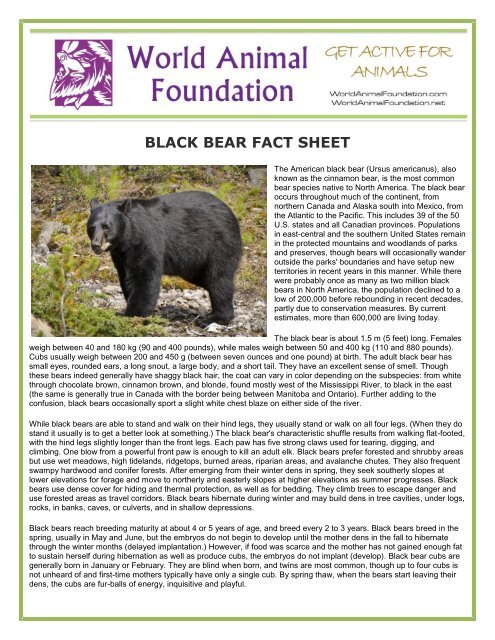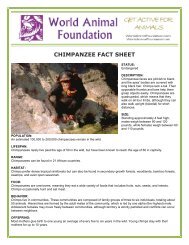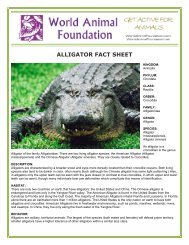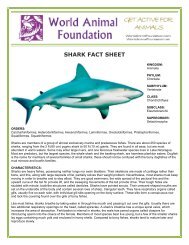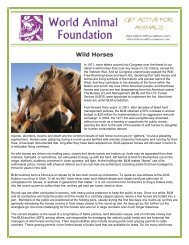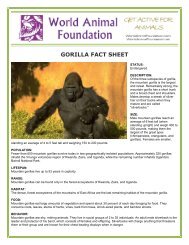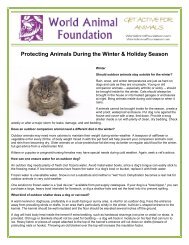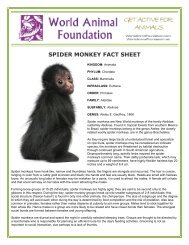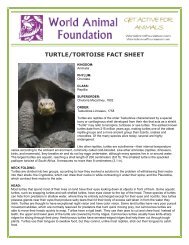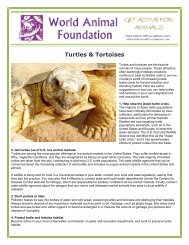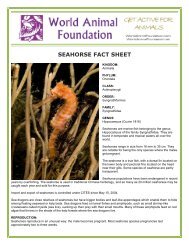BLACK BEAR FACT SHEET - World Animal Foundation
BLACK BEAR FACT SHEET - World Animal Foundation
BLACK BEAR FACT SHEET - World Animal Foundation
You also want an ePaper? Increase the reach of your titles
YUMPU automatically turns print PDFs into web optimized ePapers that Google loves.
<strong>BLACK</strong> <strong>BEAR</strong> <strong>FACT</strong> <strong>SHEET</strong><br />
The American black bear (Ursus americanus), also<br />
known as the cinnamon bear, is the most common<br />
bear species native to North America. The black bear<br />
occurs throughout much of the continent, from<br />
northern Canada and Alaska south into Mexico, from<br />
the Atlantic to the Pacific. This includes 39 of the 50<br />
U.S. states and all Canadian provinces. Populations<br />
in east-central and the southern United States remain<br />
in the protected mountains and woodlands of parks<br />
and preserves, though bears will occasionally wander<br />
outside the parks' boundaries and have setup new<br />
territories in recent years in this manner. While there<br />
were probably once as many as two million black<br />
bears in North America, the population declined to a<br />
low of 200,000 before rebounding in recent decades,<br />
partly due to conservation measures. By current<br />
estimates, more than 600,000 are living today.<br />
The black bear is about 1.5 m (5 feet) long. Females<br />
weigh between 40 and 180 kg (90 and 400 pounds), while males weigh between 50 and 400 kg (110 and 880 pounds).<br />
Cubs usually weigh between 200 and 450 g (between seven ounces and one pound) at birth. The adult black bear has<br />
small eyes, rounded ears, a long snout, a large body, and a short tail. They have an excellent sense of smell. Though<br />
these bears indeed generally have shaggy black hair, the coat can vary in color depending on the subspecies: from white<br />
through chocolate brown, cinnamon brown, and blonde, found mostly west of the Mississippi River, to black in the east<br />
(the same is generally true in Canada with the border being between Manitoba and Ontario). Further adding to the<br />
confusion, black bears occasionally sport a slight white chest blaze on either side of the river.<br />
While black bears are able to stand and walk on their hind legs, they usually stand or walk on all four legs. (When they do<br />
stand it usually is to get a better look at something.) The black bear's characteristic shuffle results from walking flat-footed,<br />
with the hind legs slightly longer than the front legs. Each paw has five strong claws used for tearing, digging, and<br />
climbing. One blow from a powerful front paw is enough to kill an adult elk. Black bears prefer forested and shrubby areas<br />
but use wet meadows, high tidelands, ridgetops, burned areas, riparian areas, and avalanche chutes. They also frequent<br />
swampy hardwood and conifer forests. After emerging from their winter dens in spring, they seek southerly slopes at<br />
lower elevations for forage and move to northerly and easterly slopes at higher elevations as summer progresses. Black<br />
bears use dense cover for hiding and thermal protection, as well as for bedding. They climb trees to escape danger and<br />
use forested areas as travel corridors. Black bears hibernate during winter and may build dens in tree cavities, under logs,<br />
rocks, in banks, caves, or culverts, and in shallow depressions.<br />
Black bears reach breeding maturity at about 4 or 5 years of age, and breed every 2 to 3 years. Black bears breed in the<br />
spring, usually in May and June, but the embryos do not begin to develop until the mother dens in the fall to hibernate<br />
through the winter months (delayed implantation.) However, if food was scarce and the mother has not gained enough fat<br />
to sustain herself during hibernation as well as produce cubs, the embryos do not implant (develop). Black bear cubs are<br />
generally born in January or February. They are blind when born, and twins are most common, though up to four cubs is<br />
not unheard of and first-time mothers typically have only a single cub. By spring thaw, when the bears start leaving their<br />
dens, the cubs are fur-balls of energy, inquisitive and playful.
When their mother senses danger she grunts to the cubs to climb high up a tree. They are weaned between July and<br />
September of their first year, and stay with the mother through the first winter. They are usually independent by the<br />
second winter. Cub survival is totally dependent on the skill of the mother in teaching her cubs what to eat, where and<br />
how to forage (find food), where to den, and when and where to seek shelter from heat or danger.<br />
Black bears are omnivores. They eat a wide variety of foods, relying most heavily on grasses, herbs, fruits, and mast.<br />
They also feed on carrion and insects such as carpenter ants, yellow jackets, bees and termites. Black bears sometimes<br />
kill and eat small rodents and ungulate fawns. Unlike the brown bear, black bears like to attack and eat dead creatures,<br />
which makes humans feigning death at bear attacks ineffective. Like many animals, black bears seldom attack unless<br />
cornered or threatened. They are less likely to attack man than grizzly bears and typically have long since run for cover<br />
before one catches sight of them. Black bear predation on man is extremely rare. It is estimated that there have been only<br />
56 documented killings of humans by black bears in North America in the past 100 years. Black bear predators include<br />
other black bears, man, and the grizzly (Ursus arctos horriblis). Coyotes (Canis latrans) and mountain lions (Puma<br />
concolor) may prey on cubs.<br />
Because their behavior has been little understood until recently, black bears have been feared and hated. Before the 20th<br />
century these bears were shot intermittently as vermin, food, and trophies being seen as either a vicious beast or an<br />
endless commodity; in many areas, bounties were paid, until recently, for black bears. Paradoxically, black bears have<br />
also been portrayed as harmless and cuddly. For example, the "teddy bear" owes its existence to a young black bear cub<br />
Theodore Roosevelt refused to shoot.<br />
Their tendencies to follow their stomachs and habitat encroachment by man have created human-bear conflicts. This is<br />
true especially in areas where they may have been uncommon or absent for a long time, as in many parts of the eastern<br />
United States.<br />
Today, a major threat to the American black bear is poaching, or illegal killing, to supply Asian markets with bear galls and<br />
paws, considered to have medicinal value in China, Japan, and Korea. The demand for these parts also affects grizzly<br />
and polar bears. The Convention on International Trade in Endangered Species of Wild Fauna and Flora (CITES), a treaty<br />
among more than 120 nations, provides measures to curb illegal trade in wildlife and wildlife products across international<br />
boundaries, helping to protect the black bear from poaching.<br />
Black bears are abundant in much of the West, in portions of the Midwest and in most of Canada. Conversely, Iowa,<br />
where land is heavily used for agriculture, has virtually none. Most eastern populations in the United States are seeing a<br />
marked, steady increase in population with bears moving back into places where they may not have been present for over<br />
a century as suitable habitat has come back. In North Carolina there were 11,000 bears at last count, Pennsylvania<br />
estimates 15,000 bears currently, and even tiny Rhode Island has seen evidence of bears moving into areas where they<br />
haven't been in decades. Unfortunately, not all is well. Two populations are at critically low levels. Two subspecies, the<br />
Louisiana black bear and the Florida black bear, still face decline mainly due to habitat loss and degradation. In Mexico,<br />
the indigenous black bear population is listed as endangered and is mostly limited to increasingly fragmented habitat in<br />
the northern parts of the country.<br />
In 1992, the U.S. Fish and Wildlife Service listed the Louisiana black bear subspecies as "threatened" under the<br />
Endangered Species Act, meaning it could be in danger of extinction throughout all or a significant portion of its range in<br />
the near future. The American black bear also is protected by legislation in the affected states (Louisiana, Mississippi, and<br />
Texas) due to its close resemblance to this subspecies. The Florida black bear is a candidate for protection under the<br />
Endangered Species Act.<br />
ENTERTAINMENT:<br />
<strong>Animal</strong>s used in the circus spend the majority of the year imprisoned in small cages or on chains, traveling from show to<br />
show. The training endured by circus animals is almost always based on intimidation; trainers must break the spirit of the<br />
animals in order to control them. While zoos and aquariums may appear to be educational and conservation-oriented,<br />
most are designed with the needs and desires of the visitors in mind, not the needs of the animals. Many animals in zoos<br />
and aquariums exhibit abnormal behavior as a result of being deprived of their natural environments and social structures.<br />
Some zoos and aquariums do rescue some animals and work to save endangered species, but most animals in zoos<br />
were either captured from the wild or bred in captivity for the purpose of public display, not species protection. The vast<br />
majority of captive-bred animals will never be returned to the wild. When the facility breeds too many animals they<br />
become "surplus" and often are sold to laboratories, traveling shows, shooting ranches, or to private individuals who may<br />
be unqualified to care for them.


